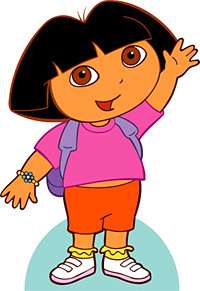 |
 |
 |
 Entertainment | May 2007 Entertainment | May 2007  
Latino Kids 'Find Themselves' in Bilingual TV Programs
 Mike McDaniel - Houston Chronicle Mike McDaniel - Houston Chronicle


| | Nickelodeon's "Dora the Explorer" |
Oye, chicos, if you're looking for some Hispanic-themed, animated entertainment in English, Univision and Telemundo are not the places to find it.

To reach Latino children in the United States, more and more shows are telling their stories in English, with a little Spanish thrown in.

Nickelodeon's "Dora the Explorer," "El Tigre: The Adventures of Manny Rivera" and "Go, Diego, Go"; PBS' "Maya & Miguel" and "Dragon Tales"; and Disney Channel's "Handy Manny" lead the way.

"Maya & Miguel" was launched in 2004 by Scholastic Productions.

"Essentially this is a company where the core of its values is about the well-being of its children and specifically their education," said Arminda Figueroa, project director.

Figueroa said Scholastic found significant demand for "this building segment of the population: Latino children."

Nickelodeon has been leading the way in this burgeoning genre, "El Tigre" being its most recent entry.

"This is about a commitment to diversity," said Tom Ascheim, the network's executive vice president and general manager. "We're a clubhouse where every kid is a member just by being a kid. If you believe that in your heart, you need to be sure kids can find themselves on the screen."

The network's No. 1 show for preschoolers, "Dora the Explorer," reaches as many as 2.8 viewers 2 years of age and older and of Hispanic origin each month, including 853,000 preschoolers.

Dora and other shows that take a bilingual tack to attract Hispanic youngsters also populate their shows with Hispanic characters and themes.

"As much as we love cartoons, we love our culture and heritage, so we've always wanted to do Mexican- and Latin-influenced art," said Jorge R. Gutierrez, who with wife Sandra Equihua created "El Tigre."

The show, about a school-age boy named Manny who becomes a superhero with a twist of his belt buckle, definitely has a unique look to it - brightly colored and energetic images with references to lucha libre and other things Mexican.

"Every place would look at my work and say, 'It's too ethnic, too Latino, we're really not making that type of show here,'" Gutierrez said. "I was constantly rejected. So Sandra and I thought the only way we were going to get work was if we gave ourselves a job. Why not pitch shows? And if we get picked up, we'll hire ourselves to work on it."

Gutierrez was raised in Mexico City, Equihua in Tijuana.

"We grew up basically watching the same stuff," said Equihua. "One of our main influences would be 'rubber hose' - Popeye and all the old Max Fleisher cartoons. We base our stuff on a lot of our favorite Mexican muralists. And on telenovelas."

Added Gutierrez, "We like to take iconic things of Latin culture - sombreros, lucha libre, mustaches, Day of the Dead - and use them in our world without explaining them. They're just there as a natural organic thing."

Manny lives with his father and his abuelo, who was in the army.

"My grandfather was a general in the Mexican army, and my dad was an architect," said Gutierrez. "That dynamic influenced the idea for those characters."

Manny's best friend Frida sometimes leads Manny down the wrong path. Might Frida be patterned after Equihua?

"I was a troublemaker when I was younger, yes," she admitted.

"We say Frida is a bad Jiminy Cricket," her husband said with a laugh.

Shows like "Maya & Miguel" and "El Tigre" are good for children, Hispanic or not, Figueroa said. Maya boasts an audience mix that's 33 percent Hispanic, 18 percent African-American and 49 percent "everything else."

"For non-Latino kids, it's so cool to learn another language," she said. "For Latinos, it's 'now I see myself for the first time, and it's so cool.'" | 
 | |
 |



